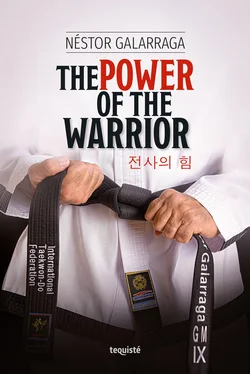1 ...6 7 8 10 11 12 ...15 With regards to the history, I would like to make a brief comment. In martial arts, as well as in many other activities, it appears that being first makes a difference; it grants an additional value. It seems that the old saying “he who strikes first, strikes twice” is fundamental and, following this criterion of alleged originality, it is possible to accommodate the past so that stories, theories, philosophies and techniques fit the present of every discipline. What nonsense to try to manipulate history! Taekwon-Do is one of the best examples: the government of South Korea tried this through the WT, World Taekwon-Do Federation, a sporting institution created by the political power of the 70´s with the only purpose of controlling Taekwon-Do, the Martial Art created by General Choi Hong Hi, between the years 1945 and 1955 and institutionalized on April 11 of 1955 in Korea. During that process, the government of Korea made an enormous effort to modify the original history, trying to erase the founder of Taekwon-do from Korean history; it manipulated the information and Korean instructors around the world with the intention to promote Taekwon-Do; the Korean government would make threats by telling them they would never see their families again if they continued working with General Choi; ultimately, they would threaten to kill their children who remained in Korea. I know this information may sound whimsical or coming out of a movie from Hollywood, but it really happened. From the 70´s onwards, information was tampered by the government of Korea, to a point where records were changed and investigations trying to show the truth about what happened in Korea during the period in which Taekwon-Do was originated were interrupted. It is important to understand that during that time in Korea, before Taekwon-Do was created, there was something different, another type of martial art, probably Judo, Karate, Kendo or, maybe, a mixture of everything but not Taekwon-Do. The discipline was developed by General Choi Hong Hi between the years 1945 and 1955 and Choi coined the name and, at first, only five patterns (tuls) were developed. With time, he began completing the discipline with the collaboration of his closest instructors. I have personally talked to all the pioneers, with the exception of Nam Tae Hi, and they all agreed that it was General Choi Hong Hi the founder of Taekwon-Do as we know it today and that on April 11 of 1955 it was officially accepted and established as the new Korean Martial Art.
Many have wondered, throughout its history, why Korea does not recognize ITF Taekwon-Do as the original Martial Art and General Choi as its founder, but this topic is a dilemma for Korea: if they were to recognize ITF Taekwon-Do as the original, it would mean that WT Taekwon-Do is a copy.
Furthermore, martial arts are built on imprecise historical stories and, of course, there are many contradictions within the disciplines themselves, which is why I believe it to be necessary to include this brief remark about it. As Grand Master Gichin Funakochi says in his biography Karate-Do, my way of life, when talking about what does not constitute a martial art: “due to the enormous amount of nonsense that has been written and said about it, when denaturing the essence of the martial art and explaining what it is not, it comes to light what martial art really is”. However, as I explained at the beginning, I will leave this topic for some other time, since this is not a book about the history of martial arts, but an attempt to express other aspects that I consider more relevant within martial arts and, particularly, within Taekwon-Do at this time.
Martial arts generally provide similar benefits. From the self-defense point of view, it develops a series of specific movements which, if subjected to rigorous training, will become an effective technique. Consequently, we will be ready to defend ourselves from any violent situation involving a physical or armed action against our own integrity. But it is important to consider that the technical aspect is only a part of the martial art.
Within these disciplines, there is a tangible contribution in the behavioral and psychological aspect as well as other matters which are more internal and profound. These millenary arts that survived changes and the passage of time became introspective disciplines promoting the constant search of the development of personal power. The struggle against our fears and limitations, on the one hand, and, on the other, matters connected with the development of personal power are our main challenge and the essence of martial arts today. It is very important to understand how these disciplines have been transforming from defense systems developed by the upper classes (many speak of systems developed by “peasants” but we should take into account that martial arts never belonged to the low classes of society) and by small groups of warriors to specialized training systems adopted by armies all around the world, used by special forces, by the police and by groups known as strike forces.
Simultaneously, they became activities closely associated with the world of amateur, Olympic and professional sports and, as of the 21st Century, they acquired a very strong educational profile. That is to say, we are now experiencing a new evolution of the martial arts, from which we can talk about topics such as personal transformation, awakening aspects of a constant improvement and helping, many times, to understand and positively change our own reality.
The teaching of martial arts begins with learning a series of movements that have nothing to do with external power. Repeating these movements, over and over again, makes us physically better, as we learn and perfect a technique and we start to understand a very important thing: willpower is an essential ability that improves with practice and introspection. It also allows us to discover the pleasure of feeling that we own our bodies. The opinions of others are no longer in command and they have no power over us.
When a child, an adolescent or an adult initiate the practice of a martial art, they discover the role of the black belt, of the instructor. It is someone who had to pass many tests and who has done much training, and —after a demanding and long learning period of acquiring knowledge and wisdom— that person is now ready to teach. Generally, the trainees discover a simple, charismatic, strong, wise person that conveys a feeling of much power. This is made visible in the way he or she walks, stands, talks, communicates, and the confidence with which he or she speaks to the students, the confidence transmitted in every movement and every one of his or her actions. That person, with ease and power, focuses on that student who approaches with uncertainty and knows not yet where he or she stands. While facing all that confusion, this role model provides certain relief and enthusiasm. It is someone that, little by little, will offer guidance because the instructor knows the steps that need to be followed in order to achieve the objective.
At the same time, there will be students from different training levels in the same group, a sort of ladder of knowledge, defined by the color of their belts and the different Dan tests. And a more or less defined path starts there: the trainee will try to follow instructions, to practice them, to work around them, to understand what it is about. The trainee has now everything in front of him or her; there is someone who will provide guidance and there is a group who will accompany the learning process.
Taekwon-Do and its stories
Taekwon-Do is a martial art in every sense of the word. This discipline was developed by General Choi Hong Hi (1918-2002) between the years 1945-1955. He developed it initially for the Korean Armed Forces, to be used as a tool for the defense of the country. Its efficiency was proved in hundreds of opportunities, particularly in the Vietnam War and by agents of the Korean Intelligence Service, during the Cold War. The same way as Judo, it became known in the world during the first War and, as Karate, it became popular during World War II; Taekwon-Do did so in the Vietnamese jungles. As it is commonly known, the United States supported South Korea for years against North Korea and the South Koreans returned Americans in Vietnam the favor. During that time, specialized training camps that reproduced the Vietnamese jungles were created in Korea, and the Korean marines were provided with special uniforms and a quite particular training. They learnt more than Taekwon-Do; something Alex Gillis in his book calls “a deadly art”.
Читать дальше












